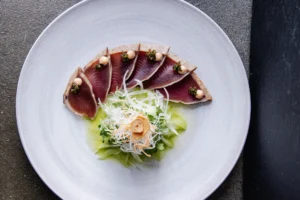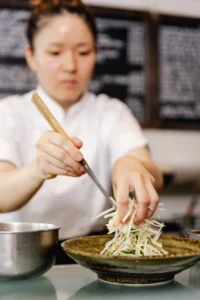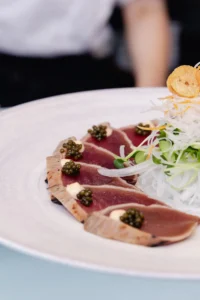Omakase Experience: Theatre of the Chef
The omakase experience is more than a meal – it’s a performance, a trust exercise, and a cultural tradition. This Japanese dining style, where guests leave the menu entirely in the hands of the chef, creates an intimate and theatrical culinary journey. But beyond the dishes themselves, what makes omakase so unique is the meaning it carries: a quiet story of trust, skill, and deep cultural roots.
What Does Omakase Mean?
 The word “omakase” (お任せ) translates to “I’ll leave it up to you.” It signals full trust in the chef. Instead of choosing from a menu, diners are guided through a sequence of dishes the chef chooses, based on the season, ingredients, and mood of the evening.
The word “omakase” (お任せ) translates to “I’ll leave it up to you.” It signals full trust in the chef. Instead of choosing from a menu, diners are guided through a sequence of dishes the chef chooses, based on the season, ingredients, and mood of the evening.
This dining style flips the script. It removes choice and replaces it with faith – faith in the chef’s hands, senses, and intuition. This level of trust shapes the entire experience, turning dinner into a personal performance.
A Tradition Rooted in Respect
In Japanese culture, respect for craft and mastery runs deep. From tea ceremonies to calligraphy, there’s great honour in dedicating oneself to a skill. Omakase follows this idea. The chef, often with decades of training, brings their full attention to the guest’s experience.
This respect goes both ways. The diner shows respect by trusting the chef, while the chef shows respect by preparing each dish with care and precision. It becomes a mutual exchange – quiet, focused, and deeply human.
The Theatre of the Experience: Omakase Experience
Every omakase meal unfolds like a play. The chef takes the stage, often behind a counter, performing with tools, fish, fire, and finesse. Each movement is deliberate. Each dish, a new scene in the story.
Unlike other restaurant settings, there’s no barrier between the diner and the kitchen. Instead, everything is on display. The sound of the knife, the smell of torch-seared fish, the gleam of fresh wasabi – all become part of the show.
Guests don’t just eat. They watch, listen, and feel. This direct connection with the chef brings warmth and intimacy. It also brings anticipation. You never know what’s coming next – and that’s part of the magic.
Storytelling Through Taste
Every dish in omakase tells a story. Some dishes may celebrate the season – like the first catch of spring. Others may honour local waters or ancient techniques. Sometimes, the chef even shares personal memories through food.
For example, a simple dish of pickled daikon might reflect the chef’s childhood. A slice of perfectly aged tuna could pay tribute to their mentor. These moments create a quiet form of storytelling – one that’s deeply personal yet shared through flavour.
Seasonal and Sensory
Omakase menus change often. That’s because they rely on the freshest ingredients available. This keeps the meal connected to nature. It also keeps it surprising.
Each season, however, brings its own tastes, textures, and colours. For example, spring omakase might include sweet prawns and cherry blossom garnish. In contrast, autumn may feature earthy mushrooms and rich, fatty fish. As a result, this rhythm keeps the experience alive and in tune with nature.
This also highlights the chef’s ability to adapt. They must understand not just technique, but seasonality, mood, and balance. The result is a meal that feels alive – never repeated, always new.
A Modern Global Appeal
While rooted in Japan, omakase has grown popular around the world. From London to New York, top chefs are adopting the style. However, even as the setting changes, the heart of omakase remains the same.
Diners still place trust in the chef. Chefs still shape each experience around quality and care. And the quiet sense of theatre – of being part of something unique – still stands at the centre.
This global reach shows how universal the idea is. People everywhere crave authenticity, connection, and surprise. Omakase offers all three.
Fusion and Innovation
Modern omakase experiences often blend tradition with creativity. Some chefs mix Japanese techniques with local flavours. Others play with presentation, lighting, and sound. This blend keeps omakase fresh while honouring its roots.
Still, the core stays intact: respect, trust, and a focus on craft. No matter the setting, those values shine through.
Why Trust Matters: Omakase Experience
 At its heart, omakase is about trust. In a world filled with choice and control, it invites guests to let go. This makes it deeply relaxing. You don’t need to decide or compare. You just need to sit back and enjoy it.
At its heart, omakase is about trust. In a world filled with choice and control, it invites guests to let go. This makes it deeply relaxing. You don’t need to decide or compare. You just need to sit back and enjoy it.
This trust also shows something bigger. It reflects cultural values – like humility, patience, and mutual respect. In many ways, omakase becomes a quiet lesson. It shows us how beautiful things can happen when we let others lead.
Building Connection
This trust builds real human connection. The chef watches the diner’s reactions, adjusting flavours as needed. The diner feels seen, heard, and cared for. There’s little talking, but a strong unspoken bond.
For many guests, this is the part they remember most. Not just the food, but the feeling of being part of something meaningful.
Final Thoughts: Omakase Experience
The omakase experience is much more than just eating – it’s an act of trust, a show of skill, and a form of quiet storytelling. Through the hands of the chef, guests are guided on a journey that reflects tradition, seasonality, and personal history.
Every slice of fish, every choice of garnish, every moment of stillness – it all adds up to something deeper. In omakase, the chef doesn’t just serve food. They offer a piece of themselves.
So, next time you take a seat at the chef’s counter, remember: you’re not just dining. You’re witnessing a story unfold – bite by bite.



